Colts GM’s Mission: ‘It Can't Just Be About Andrew Luck’

It’s not like Chris Ballard needed much more to like in Andrew Luck, and the then-Chiefs executive didn’t have any idea that he’d soon be building a team around him.
But if there were any boxes still empty, the Colts franchise quarterback checked them for him last Oct. 30. That afternoon, Ballard stayed behind in the press box after a Chiefs rout in Indy, making calls to set up Monday free-agent workouts in the wake of a slew of Kansas City injuries. Meanwhile, Luck was at a podium downstairs, beamed to a TV monitor near Ballard’s seat.
“And so I watched the press conference with Andrew, and he owned it all,” Ballard said from his new office on Tuesday. “Didn’t throw anyone under the bus. He owned everything. His mistake or not, he owned everything. And I’ll never forget going down, and I told [Chiefs GM John] Dorsey, ‘Boy, I just watched one of the best press conferences I’ve ever seen.’ A kid who owned it all. And that’s what the great leaders do—they don’t point fingers and they don’t blame.
“So I had a hint of it coming in the building, that that’s who he was. But now being around him, and watching his teammates, and how they react to him, and how they much they care about him, and on the flip side how much he cares about them and their success? It’s special. It’s really special.”
Ballard was named Colts GM three months later, and while his renovated roster has yet to go through even a single OTA session, give him this: He knows his good fortune. Most new GMs don’t get a 27-year-old prodigy as a starting point.
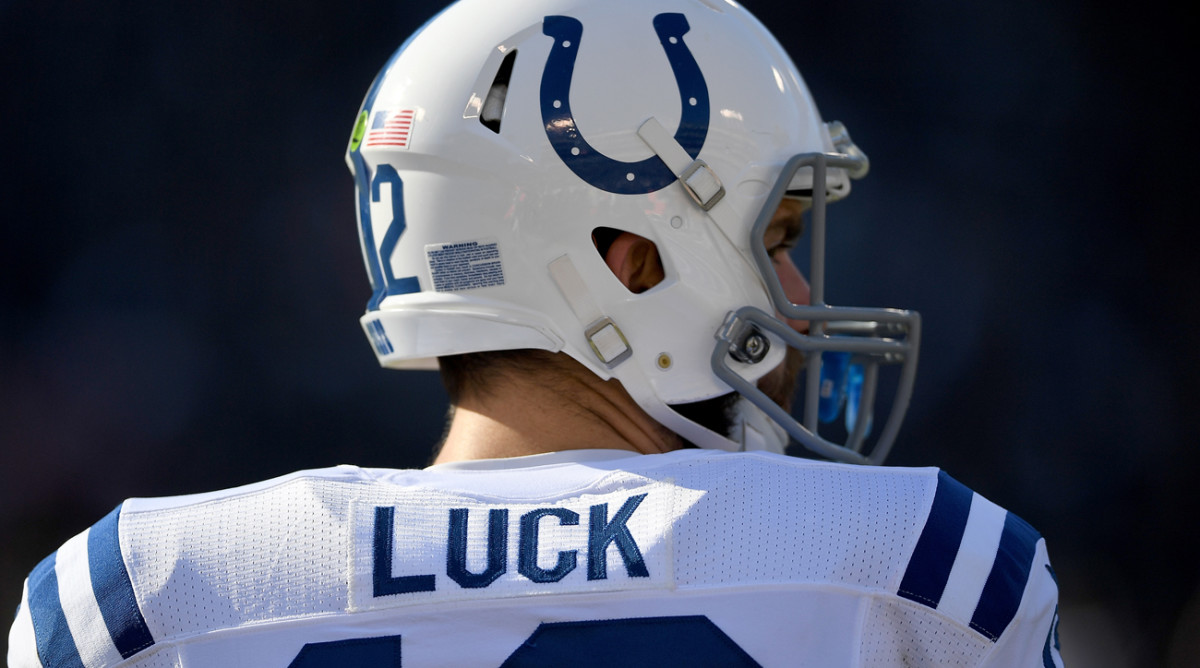
And so over the past four months, Ballard has gone about the hard part—trying to not just find better players, but more people like Luck to build out the Colts roster.
In this week’s Game Plan, we’ll look a little deeper at the NFL’s new officiating leader, dive into the enigmatic legacy of Jay Cutler, learn why Brandon Beane was the right fit for the Bills’ vacant GM spot, and look under the tree at the new toys the draft brought for Cam Newton.
We’ll start with what’s quietly happened in Indianapolis since the stunning front-office shakeup of mid-January, how Ballard has changed the makeup of the Colts roster in some respects and left it alone in others. The defense stands to have five new starters in the front seven and, if rookies win jobs in the secondary, seven new starters overall. And yet, the offensive lineup may well not undergo a single change.
So with that much movement, there are questions to answer. Why, if Luck was beat up to the point of needing shoulder surgery, weren’t there more moves on the offensive line? How do the defensive moves tie together? Where do the Colts, two years removed from a conference title game, stand now?
In a wide-ranging conversation with Ballard reviewing his first offseason as a GM, some themes emerged to answer all those questions. Let’s dive in …
THE MOLD
Ballard knew that the players would be paying attention to who he was paying, and who he was drafting, which made the first big player contract and his first pick on April 27 important. That led him to quickly zero in on Jack Doyle. He signed the incumbent tight end to a three-year deal two days before free agency began.
“We liked him in Kansas City,” Ballard said. “And finding out what he stood for—he was an undrafted kid who was cut, claimed by Indy, who had to earn his way and earn everyone’s respect, and earn his playtime. And then he produced. And he’s great in the locker room, he’s great in the community. He’s everything we want a Colt to be. That was priority No. 1, to make sure that we got Jack Doyle done.”
Seven weeks later, the Colts got lucky in having rangy Ohio State safety Malik Hooker fall to them at 15 in the first round. Hooker has a “big upside,” as Ballard put it, and “he’s a good human being … everything we wanted to stand for.” That’s not to say the Colts won’t eventually take some shots (Ballard was in K.C. when Tyreek Hill was drafted), but setting an early tone was important.
“When you pay a player who has not earned it, who is not a great worker, who doesn’t make an impact in the locker room, [players] know it,” Ballard said. “They know who’s earned it. … I’ve never been around a good team in this league where the locker room didn’t hold each other accountable, didn’t put pressure on each other to win. That’s what you have to have. They know. They know.”
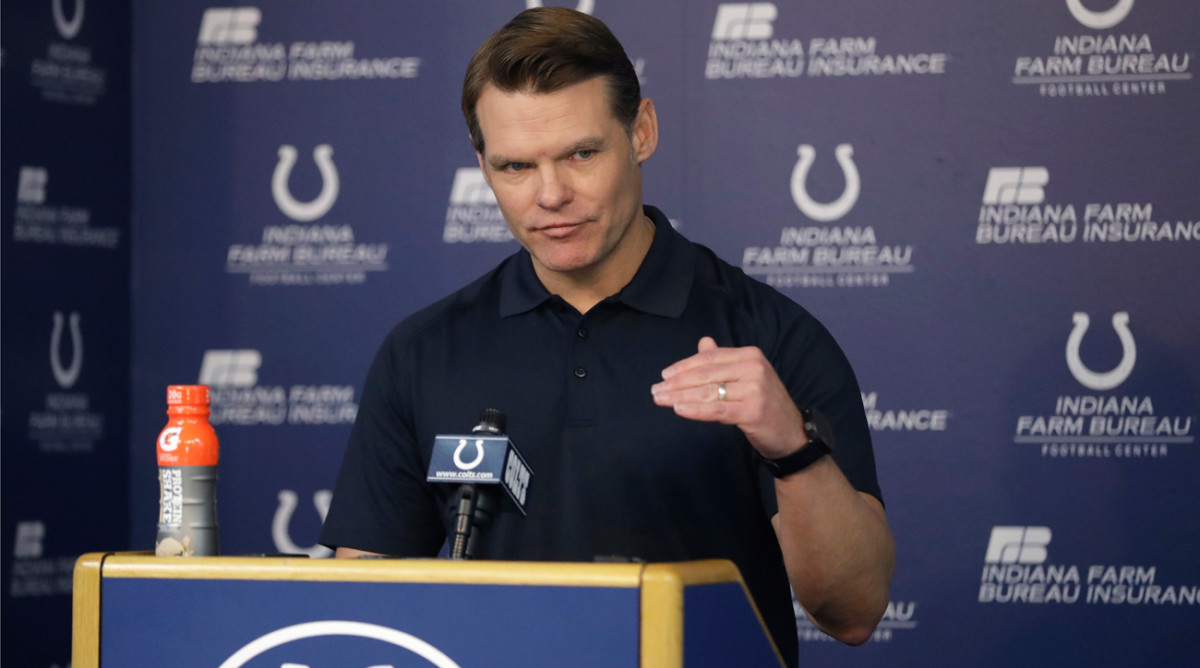
THE FRONT SEVEN
Ballard doesn’t mince words on where he wanted to act with the most urgency after he was hired. “Getting our front seven better was our No. 1 [team] priority,” he said. “That’s just how my mind works, that’s how I’ve been brought up in this league.” He saw an aging front. And he knew it’d take more than just draft picks to patch it.
“We knew we’d have to use free agency,” Ballard said. “So our thought process was, we wanted to get as many young free agents as we could to fill some spots, who still had upside. We know that’s really difficult to do in free agency, and also not be undisciplined and pay really good players superstar money. We think we got good players and paid them really good money, and they fit our needs.”
Pass-rusher Jabaal Sheard just turned 28; linebackers John Simon, Sean Spence and Barkevious Mingo are all 26. Space-eating nosetackle Johnathan Hankins just turned 25. There are a couple outliers—defensive lineman Al Woods is 30, defensive end Margus Hunt will be 30 this summer—but those guys came at between $2 million and $3 million per season. So mission accomplished.
THE CONTRACTS
Ballard mentioned paying good players really good money, rather than really good players superstar money. Hankins got $9 million per season, and Sheard is at $8.5 million. The rest come in under $5 million. Additionally, Simon, Sheard and Hankins are on three-year deals, and Spence and Mingo are on one-year deals. Add the age of those guys to the equation, and the picture comes into focus.
“We wanted to do shorter-term deals, that way all of them have a chance to hit free agency again,” said Ballard. “The flip side, for us, we know we’re gonna get the best out of them, because they know there’s another contract on the back side of this.”
After saying that, and going back to “the locker room knows” theme, the Colts GM was quick to reinforce that “every guy we’ve signed, from John Simon to Hankins to Sheard, have all earned it. All of them have earned it.” This just gives them a shot to earn even more.
THE OFFENSIVE LINE
Perception is that, given Luck’s medicals, one of Ballard’s first orders of business should have been overhauling the offensive front. Let’s just say that, after studying the roster, he didn’t subscribe to that notion.
“I’ll give [previous GM[ Ryan Grigson a lot of credit for this—he drafted [center Ryan] Kelly, [tackle Joe] Haeg and [tackle] Le’Raven Clark all in one year,” Ballard said. “Thank god he did, because [the 2017 draft] was a down year for offensive line. We gotta let those guys develop. So it’s the combination of [left tackle] Anthony Castonzo, [guard] Jack] Mewhort, Kelly, Haeg, L’Raven Clark, Denzelle Good, we signed Brian Schwenke from Tennesse, we drafted [Zach] Banner. ...
“Are we perfect yet? No. But do we have a good group to work with? I do believe that. There’s definitely hope there. Now we gotta let those guys develop.”
Ballard’s had enough options in the past to be selective about taking his shot as a GM. He wanted to raise his five kids in the Midwest. Indy was good there. Working for a football-centric owner mattered too, and Jim Irsay is that. But he won’t deny that Luck’s presence was a pretty serious carrot in his decision to leave the Chiefs.
“Everybody knows how hard that position is to find,” Ballard said. “When you have a guy with special talent at the position and he’s got special character on top of it, that’s a pretty good thing. But the one big thing I’ve made a point of here, it’s not just Andrew. We’ve got to have the best 53-man roster, and that includes Andrew.
“That’s how we’ll help him, by making the roster around him better both offensively and defensively. That’s what we’re gonna do. It can’t be just about Andrew.”
But if you look at it, it has been about finding more people like the guy Ballard saw on that TV screen seven months ago. At this early stage, it seems like the Colts have at least gotten going in accomplishing that.
* * *
FIRST AND 10
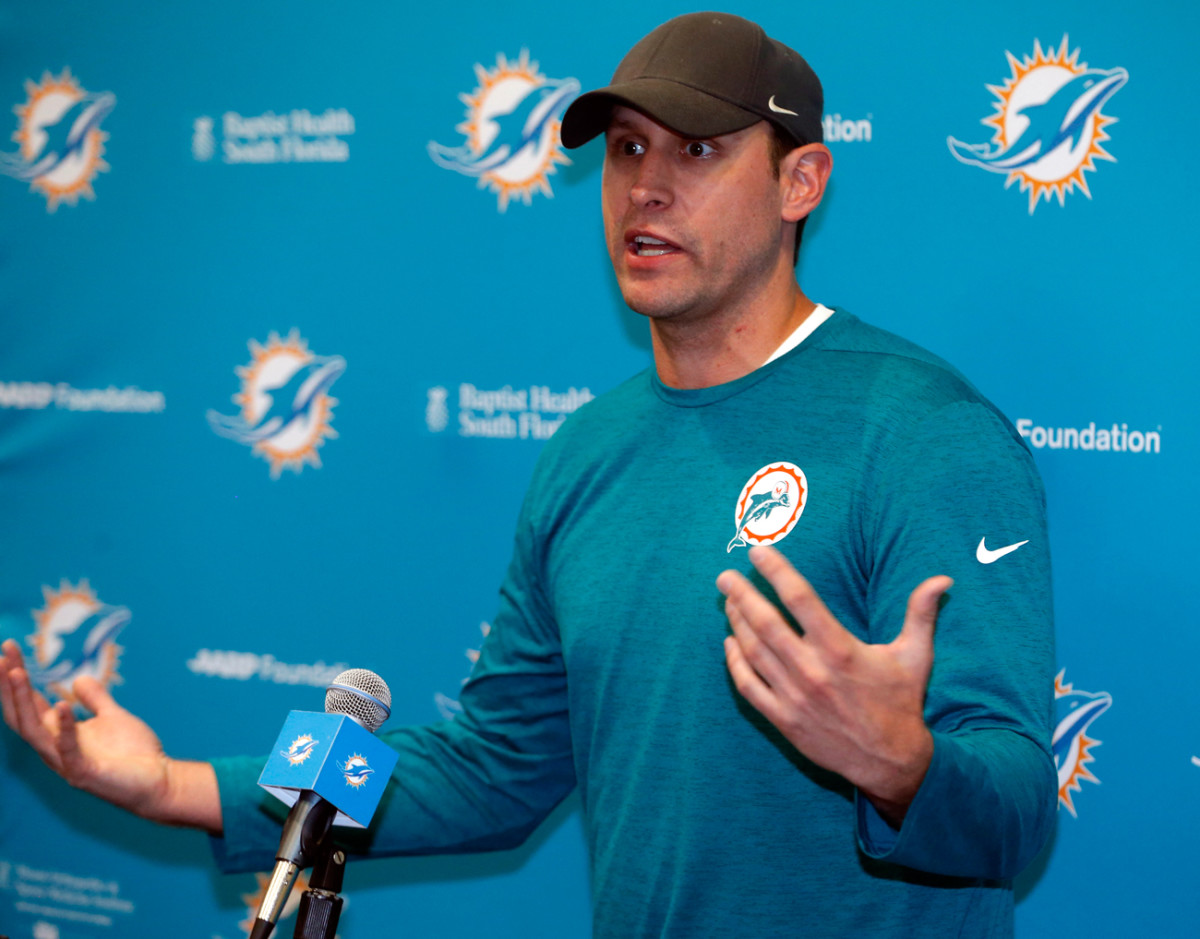
1. We mentioned in January how one thing that attracted the Colts to Ballard was his ability to build scouting infrastructure. Man, did that happen this week, with the respected Ed Dodds, Rex Hogan and Morocco Brown added to the staff.
2. Also, Indy’s hire of Brian Decker as the team’s “player personnel strategist” is fascinating. If you want more on that, check out Seth Wickersham’s ESPN piece on the Green Beret who become an expert on assessing character.
3. Want a sleeper coming out of last weekend’s rookie minicamps? Keep an eye on Oakland’s seventh-round pick Elijah Hood, a 232-pound hammer of a tailback who turned the heads of the offensive staff.
4. While we’re there, Marshawn Lynch has impressed the Raiders coaches with the kind of shape he’s kept himself. Between Hood and Lynch, and the slew of passing-down backs Reggie McKenzie has assembled, Oakland looks set at RB.
5. After rookie minicamp, and seeing corner Marlon Humphrey and rusher Tyus Bowser flash their athleticism, the Ravens are optimistic that the 2016 and ’17 drafts have met their more global goal to get deeper and faster on defense.
6. Interesting move by Dolphins coach Adam Gase to limit his rookies to meetings and walkthroughs. The idea is to mitigate the injury risk of pitting them against tryout guys, coming out of so much non-football training. Makes sense.
7. The Patriots’ tender offer to LeGarrette Blount, as Pro Football Talk reported it, looks like a “because we can” move. Now, if Blount wants to depart that crowded backfield, another team will have to be OK with losing ground on the comp-pick formula.
8. It’s not like the Cowboys’ offensive line will be a team weakness. But it’s worth watching how La’el Collins assimilates to right tackle, and how Dallas fills the vacant guard spot, with Ron Leary and Doug Free gone.
9. The idea of former Pro Bowl linebacker Daryl Washington returning to his previous form in Arizona—even returning to Arizona, period—has to be tantalizing for Steve Keim and Bruce Arians. But the drafting of another hybrid defender who can rush from the inside and outside, Haason Roddick, should tell you that they aren’t exactly counting on it. Washington hasn't played a football game in four years after being suspended for the last three-and-a-quarter seasons by the NFL for a combination of substance abuse violations and domestic violence. At 30, Washington could be a risk the Cardinals might decide isn't worth taking.
10. How the Giants deploy rookie tight end Evan Engram merits attention. The way most scouts felt: You’d have to have an in-line tight end to pair with him, because that’s not what he is. So the need for one in New York hasn’t really been filled.
* * *
FOUR DOWNS
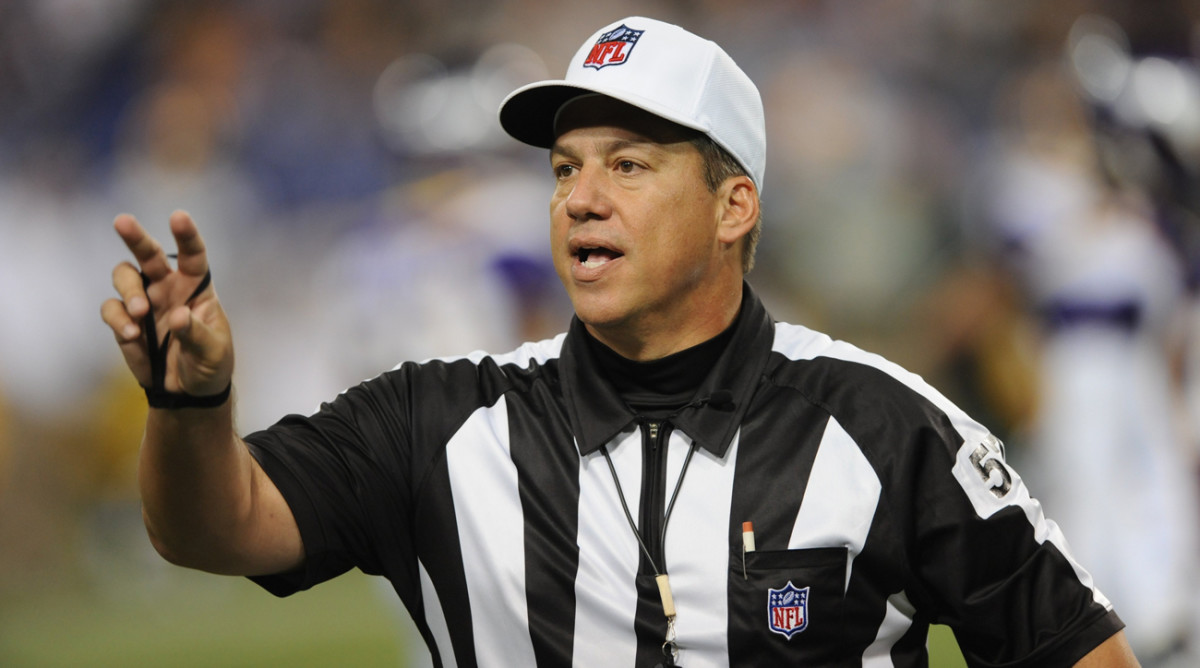
1. NFL taps its own pipeline to replace Dean Blandino. The impending departure of Dean Blandino from his role as senior vice president of officiating became public in mid-April. And at that time, I was warned that it might be unrealistic to expect his replacement to be picked before Blandino vacated his office at the end of May. In retrospect, June 1 would’ve been conservative—the league on Wednesday tabbed Blandino’s deputy, Alberto Riveron, to take his place. That should tell you two things. One, Riveron really wanted the job and, two, the NFL swiftly became convinced he could handle it.
It happened so fast, in fact, that the league was able to restructure things around the job on the fly and create two new positions—Russell Yurk is on board as VP of instant replay and administration, and Wayne Mackie is the new VP of officiating evaluation and development. This is, in essence, two jobs (those of Blandino and Riveron) becoming three, which as I understand it is recognition that the centralization of replay will make the work out of New York more demanding on everyone.
The good news is all three guys have extensive field experience. Yurk, as one league source put it, “basically wrote the manual” on replay and spent the last seven years as a replay official. Riveron spent nine years as an on-field official before coming into the office in 2013, while Mackie was on the field for the last decade. (Blandino was never an on-field official.) Beyond that, the hope here is that beefing up the power structure will help in creating more consistency across the board, and in better managing the busy early window on Sundays. Riveron, like Blandino, will serve as the public face of NFL officiating, in large part through NFL Network, and as such he’ll be tasked with building the public trust. It may be a tougher task to establish a certain private trust.
What the league worried about most in losing Blandino was finding a way to make sure the relationships and rapport between the 32 head coaches and the officiating department remain strong. There were plenty of fires Blandino put out over the past four years that never made it to the public forum, which saved the league a bunch of headaches. So job one for Riveron (Mackie, to is said to have a lot of strong relationships in the coaching world) is to re-establish himself with the coaches he knew for all those years on the field. And eventually, there’ll be the matter of whether the league should go to full-time officials, and issues related to that. For now, though, this is a pretty important item to come off the league’s spring to-do list.
2. Brandon Beane’s hire a step toward the Bills aligning things.The honeymoon is most definitely over for Buffalo owners Terry and Kim Pegula, but give them this: They aren’t afraid to dig through where they’ve created a mess, and then work to clean it up. It was pointed out to me Tuesday night, right after the Brandon Beane hire was formalized, that the GMs the Pegulas just fired in football (Doug Whaley) and hockey (Tim Murray) were pure scouts. Beane is more than that. In fact, in NFL circles, Beane is seen as more of a cap guy than an evaluator. And in his 19 years in Carolina, Beane also worked in operations and public relations, which gives him about as broad a base as you could want.
“He started here as an intern, and worked his way up, step by step,” Panthers coach Ron Rivera told me Tuesday night. “He’s been with the organization for a long time, and through a lot. He’s been in football ops. He’s been in scouting, he did evaluations. He’s worked on contracts. And if you’re going to train someone to be a GM, that’s how you do it. Brandon knows the operational side, he knows the business side, the budgets, and he did football work, evaluations, too. The decisions he made at the end of the year for us in 2012 [as interim GM] helped set the table for our breakout year in 2013.”
The short period in 2012 that Rivera is referencing—over 10 games, after Marty Hurney was fired and before Dave Gettleman was hired—is another important piece to the puzzle here. Last week, I detailed how the top task for the Pegulas with this hire was finding a way to align an organization beset with dysfunction. Well, it was basically Beane’s job to maintain the alignment of the Panthers with Rivera through the 2012 transition, and then help establish a strong connection between coaching and scouting once Gettleman arrived. So he has experience there, too. And the fact that Beane and coach Sean McDermott worked together for six years in Charlotte certainly won’t hurt either.
In many ways, the idea here follows the New Orleans model, with a versatile GM serving as a facilitator for the head coach’s vision. “He’s a tremendous communicator,” said Rivera. “He understands people, and how to deal with personalities. He wasn’t just sitting in front of a video screen. He was really valuable and a tremendous sounding board for all of us. He’s been around all of it, he gets it.” Will it work? Who knows? Beane still has a scouting staff to fill out, and that won’t be easy to do at this juncture. But at least those in Buffalo, most of all the owners, can say that the problems there previously were identified and addressed.
3. Jay Cutler’s career is one big what-if story.I remember talking to Mike Shanahan in 2013 about his return to Denver as Redskins coach, and his regret over how his 14-year tenure in the Rockies came to an end in 2008. Most of all, he reflected on how he’d felt the Broncos had finally turned the corner after rebuilding the roster on the fly. They started 8-5 that year, and held a three-game lead in the division with three games to go. Denver promptly lost three straight, and Shanahan was shown the door. At that point, Jay Cutler and promising tight end Tony Scheffler were 25, guard Chris Kuper was 26, Elvis Dumervil and Brandon Marshall were 24, and Ryan Clady and Eddie Royal were 22.
“The thing that was interesting, we were first in the AFC in offense, second in the NFL,” Shanahan said. “And the defense had lost so many people to injury. The next year, they came back and were (seventh) in the league. We had so many guys hurt. So you look at it, and I felt so good about that team. We knew it was very, very talented, and we left it in very good shape.”
Why am I telling this story now? Think about what Cutler had in front of him going into December of 2008, when an AFC West title seemed like a sure thing. He was playing for one of the preeminent offensive minds of the past quarter-century, had a veteran coordinator (Rick Dennison) and a quarterbacks coach (Jeremy Bates) who he’d grown close, and who Shanahan had given play-calling duties. And there was all that young talent around him. You know what happened instead. He immediately clashed with Shanahan’s replacement, Josh McDaniels, and was traded to Chicago. The Bears had an aging roster, and the Cutler trade stripped them of draft picks and hastened the team’s descent into decay. Over his eight years as a Bear, Cutler played for three head coaches and six offensive coordinators.
Now, it’s hard to look at someone who started for a decade in the NFL, made over $110 million, played in a Pro Bowl, and made an NFC title game as a failure. But there’s no question, Cutler’s career left you wondering what could’ve been—and if you look closely, you’ll see how circumstances (both of his fault and not) made it what it was.
4. The Redskins’ GM “search.” Back in March and early April, both Redskins president Bruce Allen and coach Jay Gruden insisted that it was business as usual for the team as it prepared for the draft following the ouster of GM Scot McCloughan. When I talked to Allen about it three weeks after the change, he certainly didn’t seem anxious about having to fill the spot, pointing to the presence of VP of football administration Eric Schaffer, college scouting director Scott Campbell, and pro director Alex Santos as enough to get the job done in the short term, and maybe the long term.
“No different than the coaching staff—I think we have some coaches that will advance in this league, and become coordinators and head coaches—I think we have some people in our college and pro departments who in the future will advance to a vice president of player personnel or general manager position,” he told me that day. “We’ll look at it as a group, and see what we need to do. … Obviously, this isn’t what I envisioned for Scot or the Redskins. Yeah, it’s disappointing, the way it ended. But in the NFL, you have to go forward, and everybody—everybody—is doing their job and is on the same page.”
So what happens if the Redskins simply shuffle some chairs? The truth is that it would be a return to the way it worked in 2014, the year Allen was promoted to president while retaining the GM title. For that season, Campbell served as director of player personnel, and Santos and Schaffer served in their current roles. Senior personnel executive Doug Williams was on board for that season too. So it’s not like the Redskins don’t have a picture of how it would work. Would it work as well as it did under McCloughan? That’s a different question.
The team’s talent—and coach Jay Gruden had a strong hand in this too—improved plenty over the past couple years, and it’s clear the Redskins benefited from McCloughan’s evaluations in this year’s draft, getting two players (DL Jonathan Allen, OLB Ryan Anderson) that McCloughan loved and graded as first-rounders, plus a player he had ranked as a Top 5 cornerback (Fabian Moreau). So structurally are they damaged? Maybe not. But there are big shoes to fill.
* * *
OFFSEASON LESSON TO TAKE WITH YOU
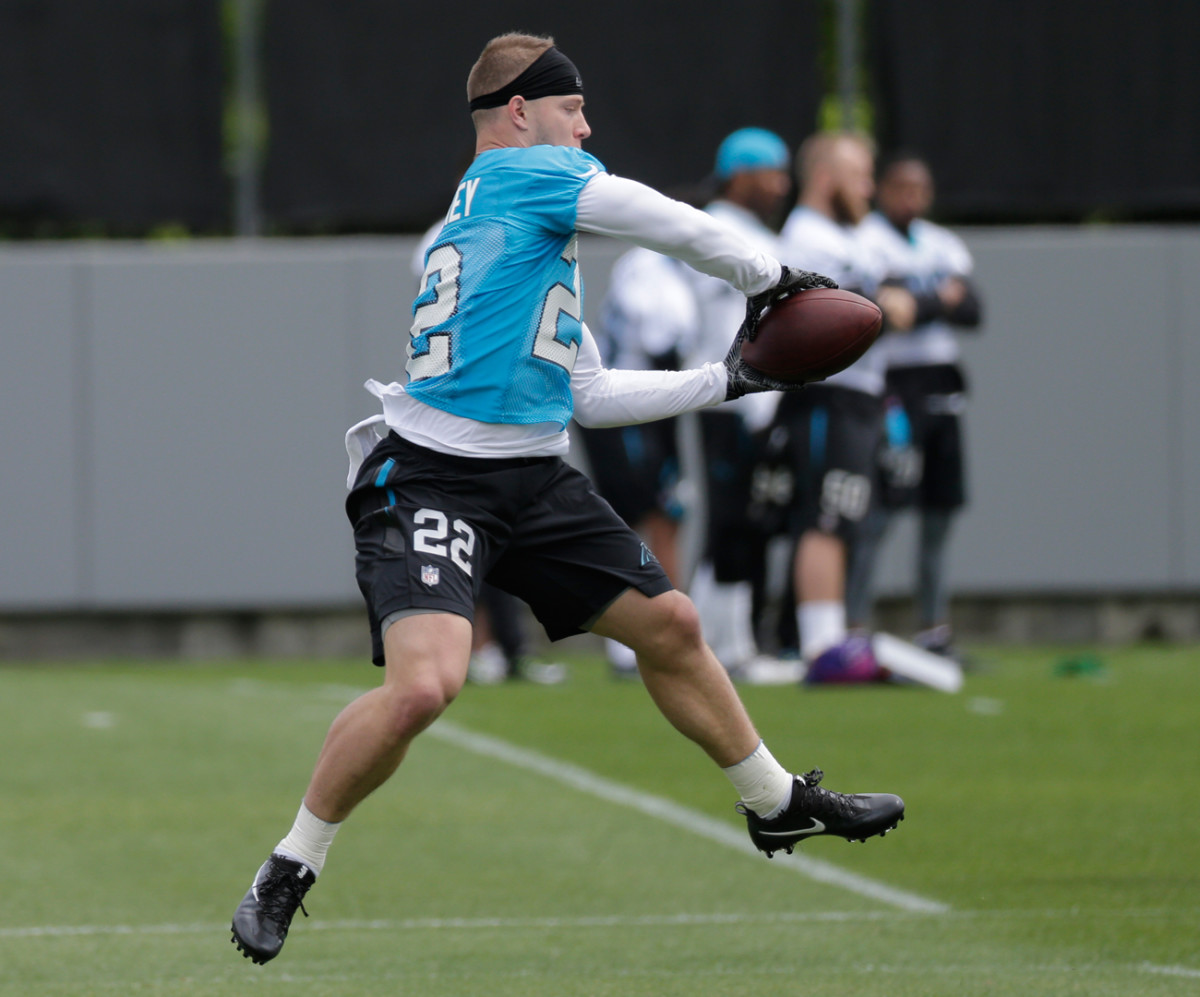
If the Panthers’ vision plays out, their offense will be breaking the huddle at some point soon, and the defense won’t have any clue where No. 22 and No. 10 are going.
First-round pick Christian McCaffrey (22) is a back who can play receiver, and is good enough at it for teams to have regarded him as a starting-level slot prospect. And second-rounder Curtis Samuel (10) is a receiver who can play tailback, and he’s good enough there to have rushed for 771 yards last year at Ohio State, a total punctuated by his iconic game-winning touchdown against rival Michigan.
Truth is, these guys are where offensive football has been going for a while. So our offseason lesson for this week is simple: NFL coaches who can adapt to the do-everything weapon will thrive. We’ve heard NFL coaches gripe about the college spread offense for years. Well, the upshot of it is now wearing Carolina blue.
For now, consider Panthers offensive coordinator Mike Shula, on one hand, a beneficiary of the growing trend and, on another, charged with figuring out how to best use two players whose listed positions seem more like suggestions.
“That’s the thing that’s good about these guys—they’re good at a lot of things,” Shula said Wednesday afternoon. “In my opinion, you can’t just say, ‘well, Christian’s a smaller guy, he’s a good outside and receiver out of the backfield.’ No, he’s a lot more than that. And you can’t say Curtis is just a screen guy. No, he’s a good route runner, he’s gonna get better, and he’s proven he can carry the football as a runner.”
Over the past couple months, Shula and his coaches ramped up their study of college offenses, including the ones Samuel and McCaffrey played (and others like Texas Tech and Virginia Tech) to find ways to build on a scheme that already carries perhaps the NFL’s most complex run game. Part of it was in evaluating players like McCaffrey and Samuel. But another was figuring out how they’d use them.
“We looked at, not just Christian and Curtis, but all those guys and how to plan if guys were available,” said Shula. “It’s important for us as offensive coaches, to present to Ron (Rivera) and to (GM) Dave (Gettleman)—‘OK, if he’s available and we draft him, this is how we’re going to use him. And here’s our plan early, we’ll start this way and grow from there.’”
Now, the good news is that, in some ways, the Panthers gradually have been built, in the growth of their option game, to absorb versatile weapons like McCaffrey and Samuel, even with more traditional position-specific guys like Greg Olsen, Kelvin Benjamin and Jonathan Stewart making up their skill group.
It’s why the Panthers probably would’ve taken McCaffrey, even if Leonard Fournette had fallen to them, and it’s why they double-downed by taking another Swiss Army knife in the second round. It evolved like this: The more they looked for ways to use Newton, the more they saw how versatile weapons from spread schools would fit, and it became apparent how dangerous Carolina could be with all of it put together.
“Cam was a trigger in that regard. Because of him, we looked at more college stuff in our research projects every year than we ever would have,” Shula said. “Now, we didn’t draft these guys to have a bunch of gimmick plays for them. That’s not why we drafted them. We drafted them because we feel like they can produce within our offense the way we have it now, and then we can add to that.
“It’s a little bit like when we drafted Cam. We weren’t going to just change everything, because he did a lot of different things than NFL teams were doing in college. We felt like he was going to be really good in what we do offensively, and then we could add to that with his ability. And each year, he’s grown and gotten better, and we’ve learned to become more flexible.”
Shula’s doing his best, for now, to not overload either McCaffrey or Samuel. “You don’t want them to be a jack of all trades, master of none,” Shula says. The goal is to make sure they’re reacting, and not thinking, on the field, and that means taking the learning process ahead step by step.
But he’ll also acknowledge that to get most out of either of these guys, the idea will be to have each doing a lot of different things. So the hope is to get there as fast as possible.
And the result, if it works, could be bringing what’s been happening in college and high school for some time to the NFL on a more regular basis.
• Question or comment? Email us at talkback@themmqb.com.
